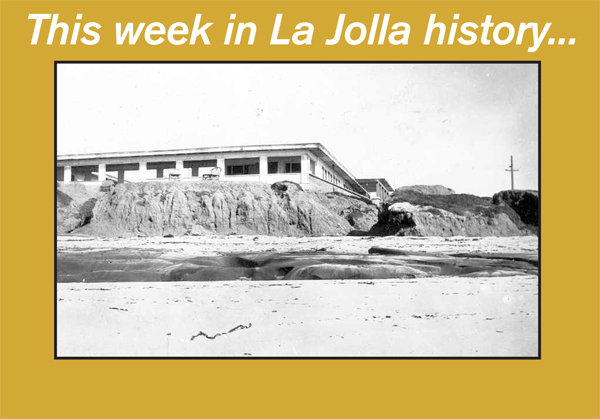
— From Linda Pequegnat’s book, “This Day in San Diego History,” available at Warwick’s and at www.sunbeltbooks.com Feb. 26, 1943 A popular resort hotel in the south section of La Jolla, the Windansea Hotel, burned down. The fire started in the kitchen at one o’clock in the morning and was discovered by the hotel managers, who risked their lives to warn the guests. All of the guests managed to escape except for one, an invalid, who apparently became confused in the excitement. The kitchen and all of the 22 rooms were destroyed. The dining room and lounge were severely damaged and had to be torn down. The Windansea Hotel was built 34 years before, in 1909, and was located south of the center of La Jolla at the corner of Neptune Place and Playa del Sur with a great view of the ocean. The hotel was a one-story wood building and had started out as a roadhouse and restaurant. A contest was held at the time to give it a name. Mrs. Montgomery Brackett won the prize of six dinners at the restaurant with her name of Windansea. The owners of the hotel estimated the fire loss to be $36,000. They said that the hotel would be rebuilt, but it never was. It is believed that the fire was caused by a gas range in the kitchen located too close to a wooden wall, which smoldered for some time before bursting into flames. Today a very popular surfing beach — Windansea Beach — is located near the location of the old Windansea Hotel, and it probably got its name from the name of the hotel. Feb. 27, 1869 Two of the first pieces of land in La Jolla were sold to two brothers, Samuel Sizer and Daniel Sizer. La Joya (as it was spelled then) was part of the city of the San Diego’s pueblo lands. Before that, La Joya had existed for many years as an Indian settlement. Pueblo lots 1259 and 1261 each contained 80 acres and were sold to the Sizer brothers for $1.25 per acre — of $100 for each 80-acre lot. The lots were adjacent to each other and were bounded by the present-day streets of La Jolla Boulevard to the west, Fay Avenue to the east, Marine Street to the north, and Palomar Avenue to the south. Today the area is primarily a residential area, situated a few blocks to the south of present-day downtown La Jolla. La Jolla High School is located today on a part of Daniel Sizer’s tract (lot 1259). A few months later, in May 1869, an article in the San Diego Union newspaper described the brothers’ lots as “a very promising place. They have good fresh water at a depth of 14 feet, and plenty of it. Their vineyard of 5,000 [grape] vines is doing well. The vegetable garden is fine. We expect to eat watermelons at this place on the 4th of July.” In 1870, while trying to dig another well, Daniel Sizer fell down the well to his death. His brother, Samuel, left the San Diego area shortly afterward. Their land, as well as many other acres of La Jolla land, was later acquired by a railroad company that was trying to buy land between San Diego and Los Angeles with the hope of constructing a railroad route between the two cities. The first real development of La Jolla didn’t begin until some 16 years later, during the real estate boom of the 1880s.












Discussion about this post